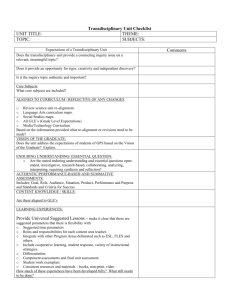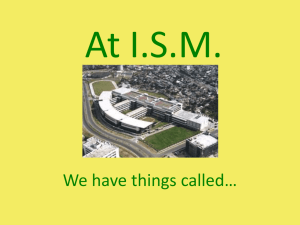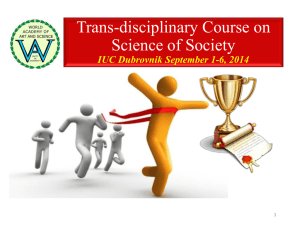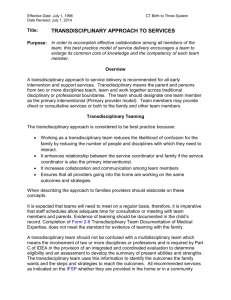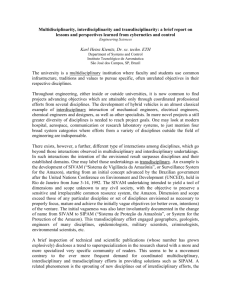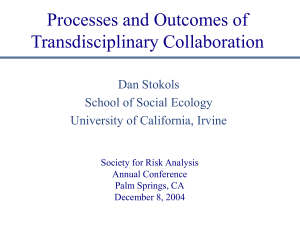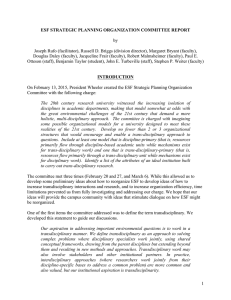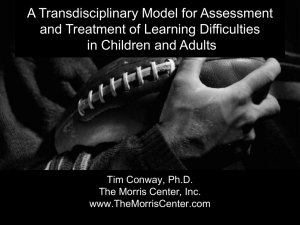Document 10465209
advertisement
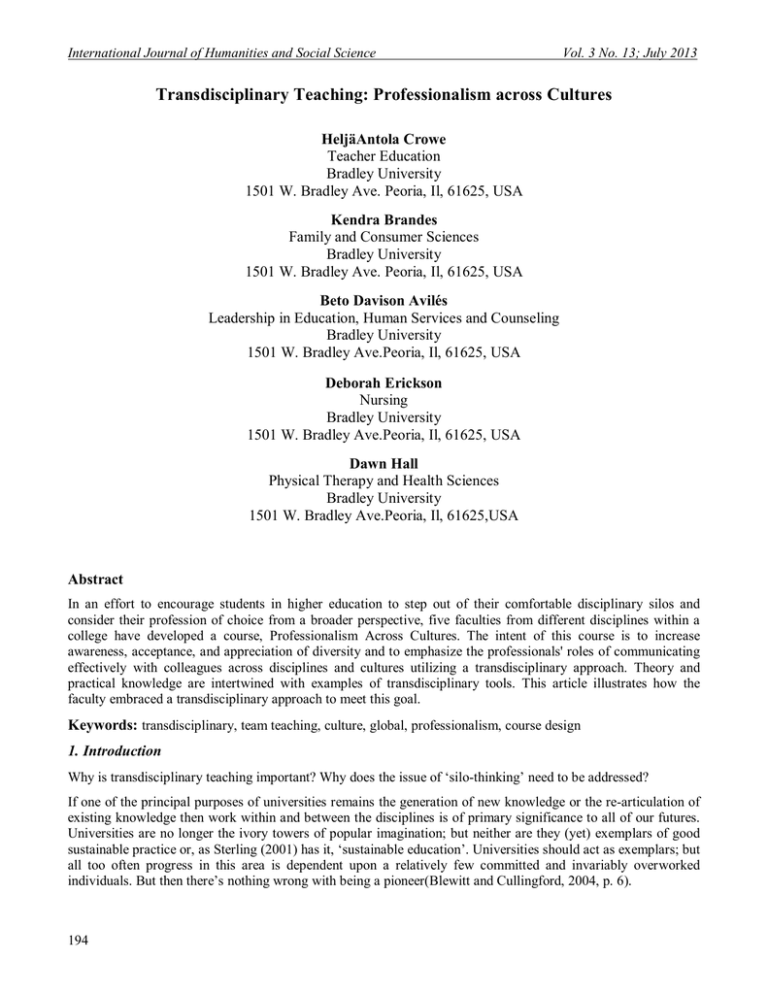
International Journal of Humanities and Social Science Vol. 3 No. 13; July 2013 Transdisciplinary Teaching: Professionalism across Cultures HeljäAntola Crowe Teacher Education Bradley University 1501 W. Bradley Ave. Peoria, Il, 61625, USA Kendra Brandes Family and Consumer Sciences Bradley University 1501 W. Bradley Ave. Peoria, Il, 61625, USA Beto Davison Avilés Leadership in Education, Human Services and Counseling Bradley University 1501 W. Bradley Ave.Peoria, Il, 61625, USA Deborah Erickson Nursing Bradley University 1501 W. Bradley Ave.Peoria, Il, 61625, USA Dawn Hall Physical Therapy and Health Sciences Bradley University 1501 W. Bradley Ave.Peoria, Il, 61625,USA Abstract In an effort to encourage students in higher education to step out of their comfortable disciplinary silos and consider their profession of choice from a broader perspective, five faculties from different disciplines within a college have developed a course, Professionalism Across Cultures. The intent of this course is to increase awareness, acceptance, and appreciation of diversity and to emphasize the professionals' roles of communicating effectively with colleagues across disciplines and cultures utilizing a transdisciplinary approach. Theory and practical knowledge are intertwined with examples of transdisciplinary tools. This article illustrates how the faculty embraced a transdisciplinary approach to meet this goal. Keywords: transdisciplinary, team teaching, culture, global, professionalism, course design 1. Introduction Why is transdisciplinary teaching important? Why does the issue of ‘silo-thinking’ need to be addressed? If one of the principal purposes of universities remains the generation of new knowledge or the re-articulation of existing knowledge then work within and between the disciplines is of primary significance to all of our futures. Universities are no longer the ivory towers of popular imagination; but neither are they (yet) exemplars of good sustainable practice or, as Sterling (2001) has it, ‘sustainable education’. Universities should act as exemplars; but all too often progress in this area is dependent upon a relatively few committed and invariably overworked individuals. But then there’s nothing wrong with being a pioneer(Blewitt and Cullingford, 2004, p. 6). 194 © Center for Promoting Ideas, USA www.ijhssnet.com Specifically, we see the transdisciplinary approach to teaching as an example of moving from traditional teaching models to a model that is sustainable and prepares the students to communicate effectively with colleagues across disciplines and cultures. In the cross-pollination of our practice of teaching our course, we are embracing the emerging culture, which is changing the way in which we are viewing our own work and interactions with our disciplines and our students. The writing of this article is an act of making this culture of collaboration visible and to engage and encourage our students to think outside a box. 2. Many forms of team teaching: toward transdisciplinary teaching A review of the literature revealed many examples, styles, and models of team teaching on all levels of education. McGregor (2006) summarizes four primary forms of team teaching including (1) monodisciplinary (seeking solutions to a problem through the lens of a single discipline), (2) multidisciplinary (professionals from two or more disciplines contribute their separate areas of expertise to a solution) (3), interdisciplinary (the transfer of methods from one discipline to another to address a problem) and (4) transdisciplinary (where new approaches are created and integrated while considering complex social issues). The distinction between interdisciplinary and transdisciplinary teaching reveals additional possibilities for new approaches to solving social issues. However, there is growing interest in transdisciplinary structure for generating new knowledge in the fertile ground, which lies in between disciplinary boundaries. (McGregor, 2006;Negre, 1999; Nicolescu, 1997; Wheatley, 1999). While no single model seems to predominate among others, this article illustrates a transdisciplinary teaching model with examples from actual practice. Rather than focusing on disciplinary approaches and specific lenses, the transdisciplinary approach we demonstrate here focuses on a larger, more holistic point of intersecting interdependent ideals of pedagogy and learning. Different from interdisciplinary teaching, our transdisciplinary approach goes beyond the simple amalgam of contributions from individual disciplines. “Transdisciplinary approaches involve multiple disciplines and the space between the disciplines with the possibility of new perspectives 'beyond' those disciplines. Where multidisciplinary or interdisciplinary inquiry may focus on the contribution of disciplines to an inquiry transdisciplinary inquiry tends to focus on the inquiry or issue itself” (Holistic Education Network, 2013). Bruder’s (1994) assumption about thetransdisciplinary approach is that team members have a continuous and purposeful reciprocal relationship. “A transdisciplinary approach requires the team members to share roles and systematically cross discipline boundaries…Professionals from different disciplines teach, learn, and work together to accomplish a common set of intervention goals ... The role differentiation between disciplines is defined by the needs of the situation rather than by discipline-specific characteristics” (p. 61). We use transdisciplinary teaching in a course called Professionalism Across Cultures (PAC). Professors from five different disciplines interactto plan and implement the course.New ideas often arise from new ways of teaching. Recently, Sterling’s (2001) sustainable education became more metaphorically evident in our professional lives when our college moved into a new LEEDS Gold building. What makes the building unique is that the old structures from 1887 were retained while the building grew four times its original size and was transformed into a green learning environment. This image has been in our minds as we moved from “ivory towers of imagination” to “good, sustainable practice.” What followed was a renaissance of change from fragmented, separated disciplines to a holistic, organic synergy. In our case, we morphed into a Global Scholar program. We went from the old ivory tower (one teacher with students in one discipline) to a transdisciplinary team approach. Our students practice utilizing tools to become life-long learners. As life-long learners they need to integrate learning, self-actualize and learn to become an active and creative explorer. In transdisciplinary collaboration perspectives come alive in face-to-face interactions. The following discussion describes the value of students’ international experiences and later, how transdisciplinary teaching supports those experiences. 3. The value of global experiences Research supports the notion that students gain valuable knowledge and experience from participation in study abroad programs.In a study of the long-term impact of study abroad, The Institute for the International Education of Students (IES) surveyed participants who had participated in IES study abroad programs over the past 50 years 195 International Journal of Humanities and Social Science Vol. 3 No. 13; July 2013 in the areas of personal growth, intercultural development, and education and career attainment (Dwyer & Peters, 2002). In the area of personal growth, respondents reported that their study abroad experience was a catalyst for increased maturity (97%), increased their self-confidence (96 %), and had a long-term impact of their world view (95%) (Dwyer & Peters, 2002). The study abroad experience also helped participants to better understand their own culture and biases (98%) and those intercultural experiences continue to impact their lives today (94%) (Dwyer & Peters). Academic outcomes for study abroad have been studied by institutions of higher education. Redden (2010) reported on a study done by the University of Georgia system to identify the academic outcomes of study abroad experiences. It was revealed that study abroad students had improved academic performance, higher graduation rates, and improved knowledge of cultural practices and cultural context as compared with the control group. Using both qualitative and quantitative methods, Ingraham & Peterson (2004) studied intellectual growth, personal growth, intercultural awareness, and professional development. Researchers reported that paired t-test results of pre- and post-surveys of students found statistically significant differences in intellectual growth, personal growth, intercultural awareness, and professional development. Qualitative measures of faculty teaching abroad reflected growth of students in the areas of intellectual growth, personal growth, intercultural awareness, and professional development. Study abroad experiences provide students with invaluable opportunities to learn about themselves and the cultures around them. 4. Starting the Global Scholar program Theauthors’ University also recognized the crucial nature of educating students in the global society. The strategic plan in 2006 stated the following: “As part of this foundation, we seek to build the intellectual tools required to participate fully in a global and diverse society” (The University Strategic Plan, 2006). In addition to the global focus, there was also an effort to encourage and support collaboration across disciplines. The disciplinary nature of academia tends to support differentiation and fragmentation of groups, persons, and ideas. This fragmentation of units, with each operating under its own explicit or implicit vision and plan for the future, will be difficult to overcome. However, collaboration across departments, programs, areas, and colleges will diminish various silos of interest. We expect collaboration to be rewarded and supported, a concept that rarely is modeled in academic communities. (The University Strategic Plan, 2006) In our college’s effort to implement the strategic plan and align our goals, we developed our Global Scholar program. The intent was to build a framework of continuity for our students to exemplify how their global experiences translate into meaningful global understanding and their ability to work within and outside of their own profession.Our college houses both the fields of education and health sciences. The disciplines of family and consumer sciences, teacher education, leadership and counseling, nursing, and physical therapy support human services within our community. The goals for the students of our Global Scholar program include the following: demonstrate increased awareness and appreciation of cultural, ethnic, and disciplinary backgrounds. identify and analyze crucial factors in developing global and cross-cultural communication and attending to issues of diversity in one’s profession. demonstrate greater awareness for global perspectives in communication, collaboration, diversity, and professional networking. collaborate and communicate effectively with colleagues and other professionals within one’s own and other cultures. demonstrate aspects of international culture and human behavior Application to the Global Scholar program includes an essay where applicants describe what has inspired them to apply to the Global Scholar program. 196 © Center for Promoting Ideas, USA www.ijhssnet.com Program requirements include foreign language, coursework in general education, international and multicultural classes in their discipline, a study abroad experience, participation in focused seminars, and twenty hours of internationally and culturally related community and university activities. Students are invited to present their study abroad experiences in a brown-bag luncheon series open to other Global Scholars and faculty. The common component for everyone in the Global Scholar program is the capstone course, Professionalism Across Cultures.Inasmuch as theory often derives from practice, the next two sections involve the description of the course and connections to theory and transdisciplinary teaching. 5. Professionalism Across Cultures course structure Professionalism Across Cultures (PAC) is a one-hour course that meets weekly and is required of all students completing the Global Scholar program in the College of Education and Health Sciences. This course is intended to provide professionals with the knowledge, skills, and dispositions relevant to recognizing, accepting, and appreciating cross-cultural, transdisciplinary, and global perspectives. The course also focuses on developing the ability and dispositions to work collaboratively with colleagues within and outside of their own discipline crossculturally. Some of the PAC course activities include discussion of professionalism and cultural differences related to the students’ fields of study; cultural identity including body image and appearance; cross-cultural knowledge, skills and attitudes; and cross-cultural business issues. All of the course objectives and activities can be found in Table 1. At the end of the semester, each student presents a project that demonstrates understanding of issues, controversies, and challenges related to cross-cultural and interdisciplinary functioning in his/her academic discipline. The course is taught by the college’s internationalization committee, which is composed of an elected member from each department. Although all five committee members participate in the teaching of the course, the designation of teacher of record rotates around the group each year. Each faculty member brings different cultural and disciplinary perspectives to the class, which serves to enrich the classroom experience for both students and faculty. The goals of this course grew from the very heart of each of the disciplines involved. Codes of conduct/ethics from each of our disciplines were examined for common threads. Each of the code of conduct documents was based upon core values that displayed surprising similarity of purpose when examined for statements related to professionalism across cultures. A sampling of the core values that were represented collectively in these documents, and that form the framework for our course is presented in Table 2. While the day-to-day activities of each of the professions represented by the teaching team differ, the fundamental principles of cultural understanding create a common base for this course. 6. Theoretical underpinnings of Professionalism Across Cultures We began the Global Scholar program prompted by a need within our college, out of which arose this teaching model. Transdisciplinary teaching is grounded in a constructivist framework where a learner-centered approach predominates. Students’ prior experiences are valued and learners’ backgrounds and cultural experiences are acknowledged (Fosnot& Stewart Perry, 2005). Learners construct concepts based on prior experiences. When teachers teach in teams, it is essential to recognize and delineate shared responsibilities and collaboration. In order to bring this about, our transdisciplinary teaching grounds itself in communitarianism, a recent philosophical idea developed in the United States in 1990 (Johnson, 2007). Communitarianism focuses on community responsibilities, highlighting such concepts as shared responsibility for social projects and community values based on universal standards. Communitarianism raises some powerful and useful ideas for educators who can choose the best it has to offer: contribution, collaboration, commitment, and conscience (Davison Aviles& Skaggs, 2012). Consistent with transdisciplinary methods, we believe our shared responsibilities help us to teach more effectively and to model best practices in inquiry based upon collaboration and commitment. Invitational theory (Purkey& Schmidt, 1987) further supports the theoretical analysis of our practice. The four anchoring principles of invitational theory: optimism, respect, trust, and intentionality are evident in the culture supporting our Global Scholar program. “Inviting people are memorable, intentionally disinviting people are unforgettable” (p. 2). 197 International Journal of Humanities and Social Science Vol. 3 No. 13; July 2013 The practice of working with each other over several years has built trust and has created an atmosphere with absence of threat. Trust-building is essential in that trust creates spaces for taking risks, creativity, and true listening to one another’s expertise and opinions.The transdisciplinary practice of continuous give and take requires intentional understanding and respect from all participants. As the team has worked together, optimism has grown as program and course-related activities have solidified. Winston Churchill once observed “ For myself, I am an optimist – it does not seem much use being anything else” (as stated in ThinkExist.com).Optimism in human relationships is that quality that sees potential where others see difficulties, opportunities where others see emptiness. It is the expectation of great things in ordinary interactions. Optimistic teachers look forward to students seeking answers and, when they find them, questioning the results. Optimistic colleagues in transdisciplinary teaching are confident in one another and show that confidence through curiosity and openness to new or different ways of looking at the world. By modeling confidence in self and one another, transdisciplinary teachers help students identify and build upon their own strengths as learners. A corollary to optimism in teaching extends self-confidence to self-efficacy. Optimism in the classroom frees students to take risks in believing in their capability to learn or carry out a certain task given the opportunity to try, rehearse, revise, re-think, re-invent, and try again until they succeed. Students and teachers in an optimistic classroom, through building effective learning partnerships, learn to respect one another. The next milestone in the inviting classroom is respect. In its most simple form, respect is having civility and good manners. It is the purposeful demonstration of caring, valuing, listening, and empathizing. An inside-out process, respect is one of the most important elements of effective teaching. This is especially true in contexts where students might be oppressed or marginalized. Gandhi wrote: My work will be finished if I succeed in carrying conviction to the human family that every man or woman, however weak in body, is the guardian of his or her self-respect and liberty. This defense avails, though the whole world may be against the individual resister. (Dayal, 2006p. 237) Whether in an actual or metaphorical sense, respect recognizes the value of the individual as he or she resists social or pedagogical oppression. In our transdisciplinary model we extend respect to include the cultures and identities of ourselves and our students. In a very real sense we are transdisciplinary multiculturalists, recognizing and respecting the teaching and helping practices of our different disciplines. Our pedagogical respect expands to include Freire’s (1970) critical pedagogy, in which students are active, critical thinkers who contribute to the creation of their own knowledge. Respect drives our practice as we empower students to become teachers of one another, simultaneously gaining knowledge of professionalism across cultures. Intentionality is the fourth foundational corner of Invitational Theory. Few practitioners and researchers, it seems, have been addressing the idea of intentionality in curriculum development and intentional outcomes as student learning. The relationship between curriculum and student learning, when pared down to its basic elements, is typically seen as an exercise in correlational logic. In terms of human interactions, intentionality seems even less well known. Indeed, Purkey (2002, p. V) observed that “intentionality has been largely overlooked”. Purkeycontinues to assert that intentionality is “the heart” of professional helping (we would include teaching) and the hallmark of professionalism. Intentionality in pedagogy, curriculum and learning implies a human relationship aspect. As instructors in this course and in our transdiscplinary teaching model, we believe that Invitational Theory and its attending relational corollaries allows us to teach college students more effectively. Chickering (1969) tells us that college students are moving along six vectors or pathways: managing emotions, moving through autonomy toward interdependence, developing mature interpersonal relationships, establishing identity, developing purpose and developing integrity. Upon closer inspection of Chickering’s (1969) vectors, there doesn’t appear to be an obvious educational goal until one considers the transdiciplinary teaching model. It is then easy to recognize that our interdependence upon one another, as intentionally inviting educators, provides a model for our students. This is precisely the time when they are developing Chickering’s behaviors required for successful college experiences. 198 © Center for Promoting Ideas, USA www.ijhssnet.com Specifically, what better way to optimize college students’ progress in developing identity, integrity and interpersonal maturity than to demonstrate it in our pedagogy? The amalgam of Chickering’s vectors and Purkey& Schmidt’s (1987)invitational theory is a basic bond that supports transdiciplinary teaching. A related way to describe transdisciplinary teaching involves what Pittinsky (2005) calls allophilia,the liking or love of the other. This term suggests a positive mindset rather than absence of bias, or tolerance towards others. Allophilia includes such aspects as kinship with others, affection for the work one does and students’ enthusiasm and comfort; aspects that members of our team recognize from their collaborative experiences. Essentially allophilia, combined with our theoretical discussion to this point, contributes to positive classroom culture and climate, which in turn is sustained through reflective practice. Reflective practice (Schön, 1987) involves thinking about teaching/learning while it happens and afterwards. That is, reflective practice includes both reflection in action while doing something and reflection after accomplishing a professional activity. As noted above, classroom climate is crucial in creating an expansive and positive mindset for learning. Effective reflective practice sustains positive classroom climate. Positivity in interactions and collaboration (Seligman, 1990; Frederickson, 2010) has profound effects by broadening the learner’s mind with flexibility, fueling resilience and facilitating connection with others. Finally, positivity (Fredrickson, 2010) makes the membrane between the teacher and learner more porous, and fosters a more expansive attitude and awareness of others (Noddings, 1992; Noddings, 2002). In this type of classroom climate caring, commitment, communication, collaboration, and creativity reside and participants may experience interpersonally and personally empowering professional interactions (Siitonen & Robinson, 1998). In summary, role modeling for students with an invitational stance that is embedded in positive collaboration is a powerful piece of transdisciplinary teamwork. In the academy teamwork, committee work, teaching, and professional development fuse together. Given this, what should classroom experiences look like both from the student and faculty perspective? 7. Classroom experiences 7.1. Characteristics of Professionalism Class Activity An example of a class activity utilized at the beginning of the semester in the PAC course addresses the concept of professionalism. After students are placed into separate groups (typically five), members of each group workcollaboratively to identify “characteristics of professionalism”. Each group then presents their work to the class, utilizing specific examples from the different disciplines of the group members. While each group is composed of students from different disciplines, characteristics identified by each group tend to be very similar. Three characteristics; communicating effectively, collaboration/compromise, and presentation, consistently are identified by all groups. Communicating effectively was described as utilizing therapeutic communication, being a good listener, and utilizing terminology that can be understood by the receiver. The traits of collaboration included being open-minded and non-judgmental, being a problem solver and team player, as well as the ability to compromise. Presentation was described as the person’s dress, hygiene, and mannerisms. Two additional characteristics, knowledge and culture, are frequently identified by most of the groups. Knowledge was described as the specific knowledge of your discipline, which is needed to interact with others to solve problems, and includes experience and technology. Appreciation of diversity appeared to be central to culture and cultural sensitivity. This activity was done during the second week of class. Both students and faculty found that the presentations reflected similar characteristics of professionalism which in itself is aconnection-making discovery for participants. The discussion on professionalism had two goals. It laid the groundwork for future class activities (See Table 1.) and it assisted students to develop the ability and dispositions to work collaboratively with colleagues within and outside their discipline. 7.2. Cultural potluck One of the favorite class activities for both faculty and students is the cultural heritage potluck dinner, which is held in a faculty member’s home. Students and faculty share a dish that represents their culture. Each individual is to bring a dish that represents some aspect of his or her culture. 199 International Journal of Humanities and Social Science Vol. 3 No. 13; July 2013 A member of our teaching team observed that Each year I am faced with the same question: what food could I bring that explains who I am? Each year I reinvent myself. I find a different aspect of my life and my heritage to share with the group. The decision of what dish to bring each year has caused me to examine the details of my personal life as well as my heritage from many branches of the family tree. Nicolescu (1997) describes transdiciplinarity as a means to self-transformation. I have developed new ways of examining my own culture and personal beliefs. This activity is practical but also complex in that each person needs to work on articulating who they are as a professional and how their culture and experiences inform that professionalism. This experience provides an opening of spaces between disciplines and pulls us toward a self-transformation toward transdisciplinary experience. Other activities in the course (Table 1.) are aligned with objectives of the course with an emphasis on life-long learning and practicing to become a reflective Global Scholar. 8. Challenges in course implementation There are numerous challenges in implementation of this course. Faculty volunteer their time to team teach this course anddo not receive workload credit while teaching it. Scheduling is also a challenge with faculty schedules from different departments as well as the students from the different departments with their practicum experiences and regular coursework. An additional section was added to the course to facilitate the student enrollment when their individual schedules prevent them from participating at the scheduled time. Videotaping is arranged for those students who can’t attend the class as scheduled. Students who participate in the additional section have a different experience since they are not able to participate in classroom discussions. Another challenge is the amount of content that faculty believe needs to be included in the allotted one-hour time frame. Due to the many facets of the administration of the course, the faculty team is asked to be even more flexible that in regular courses. We arrive in class well in advance to discuss the particulars of each class meeting. We discuss the day’s agenda and how it will be implemented, as well as what we will be doing in the near future: who teaches what piece, where, how, and which assessments we will use. These weekly meetings are an opportunity for constant reflection on how this course contributes to the whole Global Scholar experience for our students.The complexity of everyone’s schedules requires that we are very intentional about communications within the team and with the students. In order to truly follow constructivist teaching, the optimal class size is no more than fifteen. 9. Faculty Perspectives 9. 1. Individual Faculty Perspectives In the following each writer shows in their own voice the implications of the collaboration to their work. Counseling and Leadership Faculty: I learned that teaching is not a spectator sport. I learned that I can be a good teacher, but that we can be excellent teachers. I learned that transdiciplinary teaching is an effective way to bring together students and faculty in a way that transcends professional barriers and produces holographic or multidimensional learning. As a team we model the kinds of professional interactions that we hope our pre-professional students will be able to use in their careers. Teaming together requires flexibility of thinking and a willingness to let go of preconceived ideas or pedagogical approaches. In our team nobody is trying to be dominant. In a team member’s words: “Class is neutral ground not in terms of values but in terms of power!” Shared teaching where everyone’s voice is valuable. Everyone brings in a willingness to work together. As a volunteer transdisciplinary team, we believe the process works. We have learned perspective-taking from each other. Family and Consumer Sciences Faculty: I teach courses primarily in apparel studies, one area within the discipline of Family and Consumer Sciences (FCS). Apparel studies are rich with cultural meaning and history. Textiles originate in cultural practices from around the world. Fashion trends shift with focus on world events. The terminology of my field is deeply rooted in the language of faraway places. I was, therefore, pretty comfortable with the notion that I had a good grasp of the impact of culture in my area of study. 200 © Center for Promoting Ideas, USA www.ijhssnet.com I think that I initially brought the concept of my area of study into the group when I joined the teaching team. I thought about what topics myarea of study could contribute to the team effort. Five years later, the boundaries of my area of study seem to have blurred. From my colleagues I have learned to think of culture it its many forms (age, gender, disciplinary background, ethnicity, geographic origins, etc.) and to examine how issues of professionalism span our areas of study. For example, I might have had an understanding of the history and social mandates requiring women in some cultures to keep much of their body covered, but had not appreciated the impact that this practice might have when a nurse or physical therapist has a woman from this culture as a patient. How could knowledge from apparel studies and the health professions merge to address the issues of professionalism in this type of situation? Participation with this teaching team has also given me the opportunity to examine my own culture in ways that I had not thought about. In terms of family traditions and practices, I have learned that I am not sure how to define my own culture. I find a different aspect of my life and my heritage to share with the group. The decision of what dish to bring each year to the potluck has caused me to examine the details of my personal life as well as my heritage from many branches of the family tree. As a result of working within a transdisciplinary environment, I have discovered new models of reflection where my own life experiences are concerned. Physical Therapy Faculty: Benefits from teaching this course are many. Higher education is often taught in a segregated disciplinary fashion (meaning there is often little collaboration of diverse professions), yet the world, in which our students will be interacting, is becoming more integrated with varied ideas, values and beliefs. Hence, a course like PAC is one that, I believe, students recognize the interconnectedness of different professions thereby making them more aware of the professional similarities and differences, more culturally astute, and better prepared to identify possible cultural conflicts that may affect them within the community or at work. In addition, faculty are able to query students from a different professional perspective in hopes to engage the students’ mind to think beyond their own professional culture and initiate the integration of connectedness between the various professions. This type of course is advantageous because it demonstrates the need for life-long learning. Students become aware of this by the questions the faculty asks of them and faculty acknowledge this when students present topics of interest that we, as faculty, have not contemplated but find of value to our professional knowledge. This type of course not only benefits the students who matriculate within it but also other students in different courses that the interdisciplinary team teaches. Faculty are able to take the lessons learned and incorporate them into other course in order to enhance the learning experience of all students that encounter these faculty. As the PT faculty, I am able to glean from PAC presentations and create cases for my students to engage them in a cultural conversation to better assess their awareness and application of cultural competence. For example, in the PAC course a student may present on a certain cultural dance. For my PT students, I can create a case were the patient/client is a dancer. I am able to 1) assess the PT student’s cultural sensitivity to the patients’ activities, 2)measure the PT student’s level of cultural competency (i.e. did they research or ask to describe the dance), and 3) evaluate the PT student’s ability to incorporate the patient’s culture into the prognosis, treatment, and goals in order to address the patient’s quality of life. In essence, the PAC of course has the potential to benefit not only those who enroll within it but also those students in which the faculty teach in other courses as well. The PAC course promotes growth for faculty and their students. This type course highlights the fact that no one profession operates independently of others, this course helps students and faculty to recognize how diverse professions are woven together in an integrative, transdisciplinary manner, much like the world we live in. Nursing Faculty: As a faculty member team teaching in the PAC course, I have been inspired by my fellow faculty and the students. While I have learned more about the different disciplines of my fellow faculty, I have also learned from their life experiences. Two faculty are bilingual and I respect their ability to communicate effectively in two different languages. And they continue to learn words in other languages by asking students to share phrases from other languages that are different from their own. While I speak some basic German, I have found myself wishing that I had had more opportunities to speak German on a regular basis. Students are eager to share information about their own culture and the cultural experiences they had had while studying abroad. 201 International Journal of Humanities and Social Science Vol. 3 No. 13; July 2013 While sharing my experiences from a visit to Barcelona, I stated that I did not feel comfortable exploring the city on my own because I did not speak Spanish. A student, who spoke Spanish fluently and had traveled to Barcelona, shared that while she understood my reluctance, she also had faith in me and my ability to communicate with others. Teacher Education Faculty: My time in team-teaching Professionalism Across Cultures has been an unexpectedly invigorating experience. The variety of disciplinary approaches we bring together when defining culture and learning through interactions with each other. Wehave worked together (and gradually become a we), learning to know each others’ perspectives more closely and grown in trust and appreciation for what each person brings to the plate. From the perspective of teacher education this is a real-life practice for working in a team of professionals, much like what teachers are asked to do in the schools. For me as a teacher educator this experience is about learning to learn, planning and implementing lessons, understanding diverse learners, discussing assessments and addressing issues relating to the complex world of classroom life, and dealing with teachable moments arising from unexpected environmental and interactional factors. This work allows room for creative pedagogical imagination. It includes the growing as a professional teacher, developing our professional repertoire, and learning to interact with other colleagues. As a teacher teaching teachers how to teach, the teaming with other professors has been a welcome reminder to model the collaborative relationships with other professionals. Author background characteristics are shown in Table 3. The characteristicsreflect the diversity the students are exposed to when taking the PAC course. 9.2. Conclusion: Transdisciplinary perspective As discussed earlier, aspects of intentional theory: optimism, respect, trust and intentionality (Purkey& Schmidt, 1987) and allophilia (Pittinsky, 2005) are a reality within this team. Transdisciplinary teaching energizes us! We believe in what we are doing and how we are influencing the next generation of professionals. We don’t feel threatened to ask questions and with a positive attitude we do the work that needs to be done. Together we have learned how to create and manage flow and momentum in the classroom with many moving parts and complex issues. Perspective–taking grows naturally when colleagues learn to know each other’s disciplinary thinking, knowledge base, and experiences. Much of this knowledge is tacit that becomes visible in the interactions within the course. Prior to the collaboration with the Global Scholars program and the PAC course, there were typical interactions between the colleagues from departments -- two college-level meetings and university-wide annual conference. Silo-thinking and silo-functioning were quite typical. Through this teamwork we have become visible to each other not just on the plane of awareness as belonging to the same college, but visible as real colleagues with distinct characteristics we work with and share experiences with as a learning community. In collaboration, we search for paths to discuss ideas in ways that make sense to this community of learners and to discover common strands between our disciplines. This collaboration, transdisciplinary in nature, welcomes the connectedness of knowledge between our disciplines and interrelatedness of knowledge bases. To understand other people Delors (as cited in Blewitt, 2004) suggests four pillars: learning to do, learning to know, learning to be and learning to live together. Learning to do includes activities and exercises we have developed and use in the PAC course. Learning to be refers to our thinking about our self-identities and questioning how our disciplinary viewpoints contribute to the discussion and inviting our students to do the same. Learning to know individually and together is a journey the team has taken together while learning with the students as they present their research. Learning to live together is a factor of consistency in the team over an extended period of semesters, an empowering and life-sustaining experience growing out of our volunteer task. 202 © Center for Promoting Ideas, USA www.ijhssnet.com References American Association of Family and Consumer Sciences (AAFCS). (2012).Code of ethics.Retrieved from http://www.aafcs.org/AboutUs/CodeEthics.asp American Counseling Association. (2005). Retrieved from http://www.counseling.org/resources/aca-code-ofethics.pdf American Nurses Association (ANA). (2001). Code of ethics for nurses with interpretivestatements. Silver Spring, MD: American Nurses Association. American Physical Therapy Association (APTA). (2009). Code of ethics for physical therapist.Retreivedfromhttp://www.apta.org/uploadedFiles/APTAorg/About_Us/Policies/Ethics/CodeofEt hics.pdf Blewitt, J.,&Cullingford, C. (2004) The sustainability curriculum: The challenge for higher education. London, England: Earthscan. Bruder, M.B. (1994). Working with members of other disciplines: Collaboration for success. In M. Wolery& J.S. Wilbers (Eds.), Including children with special needs in early childhood programs (pp. 45-70). Washington, DC: National Association for the Education of Young Children. Chickering, A. W. (1969).Education and identity.San Francisco: Jossey-Bass. Davison Avilés, R., &Skaggs, J. L. (2012). A primer on organizational ethics and leadership for professional school counselors. International Journal of Humanities and Social Science, 2(16), 52-59. Dayal, P. (2006). Gandhian theory of social reconstruction. New Delhi, India: Atlantic Publishers. Dwyer, M. M., & Peters, C. K. (2002). The benefits of study abroad: New study confirms significant gains. Institute for the International Education of Students. Retrieved from https://www.clarku.net/offices/studyabroad/pdfs/IES%20Study.pdf Fosnot, T. C. & Stewart Perry, R. (2005). Constructivism: A psychological theory of learning. In Fosnot (Ed.) Constructivism. Theory, perspectives, and practices (pp. 8-38) New York: Teachers College Press. Frederickson, B. L. (2010). Positivity. New York: Three Rivers Press. Freire, P. (1970). Pedagogy of the oppressed. New York: Continuum. Holistic Education Network. (2013). Holistic Education. Retrieved fromwww.hent.org/transdisciplinary.htm Ingraham, E.C., & Peterson, D. L. (2004). Assess the impact of study abroad on student learning at Michigan State University. Frontier: The Interdisciplinary Journal of Study Abroad, 10(fall), 83-100. Johnson, C. E. (2007). Ethics in the workplace.Thousand Oaks, CA: Sage. McGregor, S. (2004).The nature of transdisciplinary research and practice.Retrieved from http://www.kon.org/HSwp/archive/transdiscipl.pdf McGregor, S. (2006).Transformative practice: New pathways to leadership. Lansing, MI: Kappa Omicron Nu Honor Society. Mezirow, J. (1991). Transformative dimensions of adult learning. San Francisco: Jossey-Bass. National Association for the Education of Young Children. (2011). Code of ethical conduct and statement of commitment. Retrieved from http://www.naeyc.org Nègre, A. (1999). A transdisciplinary approach to science and astrology.Retrieved fromhttp://cura.free.fr/quinq/02negre2.html Nicolescu, B. (1997). The transdisciplinary evolution of the university condition for sustainable development.Retrieved from http://perso.club-internet.fr/nicol/ciret/bulletin/b12/b12c8.htm Nicolescu, B. (2001).Manifesto of transdisciplinarity. Albany, NY: State University of New York Press. Noddings, N. (1992) The challenge to care in schools : An alternative approach to education. New York: Teachers College Press. Noddings, N. (2002).Starting at home: Caring and social policy. Berkeley: University of California Press. Pittinsky, T. L. (2005).Allophilia and intergroup leadership. Retrieved from http://papers.ssrn.com/sol3/papers.cfm?abstract_id=739705 Purkey, W. (2002). Foreword. In Schmidt, J. J.Intentional helping: A philosophy for proficient caring relationships (pp. V-VI). Upper Saddle River, NJ: Merrill, Prentice Hall. Purkey, W.,& Schmidt, J. J. (1987).The inviting relationship: An expanded perspective for professional counseling. Englewoods, NJ: Prentice-Hall. Redden, E. (2010). Academic outcomes of study abroad.Retrieved fromhttp://www.insidehighered.com/news/2010/07/13/abroad 203 International Journal of Humanities and Social Science Vol. 3 No. 13; July 2013 Siitonen, J. & Robinson, H. A. (1998). Empowerment: Links to teachers’ professional growth. In Erkkilä, R. Willman, A. & Syrjälä, L. (Eds.), Promoting teachers' personal and professional growth(pp. 165-191). Oulu, Finland: Oulu University Press. Schmidt, J. J. (2002). Intentional helping: A philosophy for proficient caring relationship. Upple Saddle River, NJ: Merrill, Prentice Hall. Schön, D. A. (1987).Educating the reflective practitioner: Toward a new for teaching and learning in the professions. San Francisco: Jossey-Bass. Seligman, M. (1990). Learned optimism. New York: Simon & Shuster. Sterling, S. (2001). Sustainable education: Re-visioning learning and change. Bristol, Englan: Schumacher Society. Sterling, S. (2004). An analysis of the development of sustainability education internationally: evolution, interpretation and transformative potential. In J. Blewitt& C. Cullingford (Eds.), The sustainability curriculum: the challenge for higher education (pp. 43-62). London, England, Earthscan. ThinkExist.com. (2013).Churchill quotes. Retrieved from http://thinkexist.com/quotation/for_myself_i_am_an_optimist-it_does_not_seem_to/182800.html University Course catalog, (2012, August). Undergraduate Catalog. Retrieved from http://www.bradley.edu/academic/undergradcat/20122013/ University Strategic Plan (2006).Strategic Plan 2006-2011.Retrieved from http://www.bradley.edu/sites/strategicplan/20062011/ Wheatley, M. (1999).Leadership and the new science. San Francisco: Berrett-Koehler. World Health Organization (n.d.).Respecting and promoting individual and cultural differences, effective behavior #3. Retrieved from http://www.who.int/employment/who_we_need/en/ Table 1. Professionalism Across Cultures Course Objectives and Activities Course Objectives 1. Demonstrate increased awareness and appreciation for your own and others’ cultural, ethnic, disciplinary backgrounds. 2. Examine major social, professional and educational issues related to cross-cultural communications. 3. Identify and analyze crucial factors in developing global and cross-cultural communication and address issues of diversity in your profession. 4. Develop greater awareness for global perspectives within the issues of communication, collaboration, diversity, and professional networking. 5. Maintain a positive view of other disciplines, community contexts, and potential for sources of information. 6. Collaborate and communicate effectively with colleagues, and others, within one’s own and other cultures. 7. Demonstrate increased awareness of world economic development and how it affects cultures. 8. Recognize and appreciate aspects of international culture and human behavior. 9. Define professionalism. 204 Activities Introductions Potluck dinner, Cross-cultural knowledge, skills and attitudes Faculty mentoring with research project, Small group cluster assigned to a faculty member Cultural dimensions Issues of diversity; professionalism exercise Cultural identity through body image and appearance Topic specific contributions Interactions with one another Country of interest activity Collegial interactions overall in the course Final project presentation with purposeful communication with representatives from other disciplines Peer feedback of presentations Encouraging questions with presentations Brainstorming on professionalism Evaluation of presentations Cultural dimensions Research topics Visit by international students Country of interest project Group brainstorming of professional characteristics. Comparison across disciplines. © Center for Promoting Ideas, USA www.ijhssnet.com Table 2. Professional Codes of Conduct Core Values identified Across Disciplines To define culture in the broadest sense The recognition of the importance of the individual and the family within larger social structures. Call for awareness of one’s own culture Continuing education in topics related to knowledge of culture Examples from professional Codes of Conduct “Physical therapists shall act in a respectful manner toward each person regardless of age, gender, race, nationality, religion, ethnicity, social or economic status, sexual orientation, health condition, or disability”. (American Physical Therapy Association, 2009) “Counselors communicate information in ways that are both developmentally and culturally appropriate.” (American Counseling Association, 2005) “The nurses’ primary commitment is to the patient, whether an individual, family, group, or community.” (American Nurses Association, 2001). “Recognize that children are best served and supported in the context of family, culture, community, and society”. (National Association for the Education of Young Children, 2011) “Examines own behavior and attitudes to avoid stereotypical responses” (World Health Organization, n.d.) . . . to “obtain education, training, and experience to provide competent services to persons of diverse backgrounds or persuasions”. (American Association of Family and Consumer Sciences, 2013) Table 3. Background characteristics of writers Faculty discipline Gender Ethnicity, race and language Years of teaching International experience Teacher Education Faculty Female Dual citizen of Finland and the U.S. Bilingual 29 Finland, Foreign exchange, collaborations with Asia, Europe, Central America, Study Abroad in China, Finland Family and Consumer Sciences Faculty Female CaucasianAmerican 20 Lived abroad in Scotland Personal travel in Europe and Asia Counseling and Leadership Faculty Male Latino, Bilingual English and Spanish 25 Childhood in Mexico Nursing Faculty Female CaucasianAmerican 30 Foreign exchange student in Germany, personal travel Physical Therapy Faculty Female American, Black 13 Study Abroad in Europe, Medical Missions in Africa, Caribbean, personal travel 205
